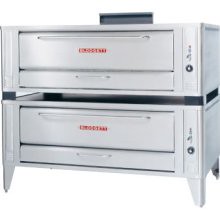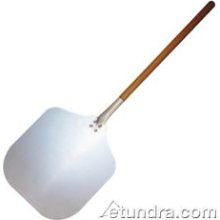In this episode – the next to last, for those who are getting bored – I’ll reveal the innermost secrets of the pizza oven-tender. A delivery pizza would not be very much use to you if delivered raw (or burnt to a crisp), so it could be argued that this position is one of the most important.
 Across the aisle from the itemizing area were a honking big set of Blodgett ovens; two ovens with doors 5 feet wide and decks about 3 feet deep stacked atop one another. They were gas fired and the gas burners heated the 3/4” thick slate slabs that formed the floor of the ovens. We ran them at 400 degrees. Want a pair of these beauties for your kitchen? They’ll only set you back about 18 grand!
Across the aisle from the itemizing area were a honking big set of Blodgett ovens; two ovens with doors 5 feet wide and decks about 3 feet deep stacked atop one another. They were gas fired and the gas burners heated the 3/4” thick slate slabs that formed the floor of the ovens. We ran them at 400 degrees. Want a pair of these beauties for your kitchen? They’ll only set you back about 18 grand!
 To get the pizzas into and out of the oven, we used a pizza peel – which looked a little like a giant aluminum fly swatter, but we NEVER swatted flies with it; I swear. The technique was to grab the long wooden handle about half-way along its length so the end of the handle lay under your forearm and gave you leverage. Slide the peel under the completed pizza (on an expanded metal screen) and lift. The peel was quite slick, on a busy night you didn’t have time to move gingerly. To keep the pizza on the peel meant learning to “bank” the peel as you swing around 180° to put it in the oven the way a motorcyclist leans into turns to keep from being thrown off the bike, lift the nose as you reach into the oven to prevent the pie from sliding off the end of the peel and splatting all over the back of the oven, then gently deposit it on the deck with a quick backward jerk of the peel. As soon as it was itemized the pie needed to be in that oven, so we mastered the laws of pizza physics and practically flung those pies into the inferno – but in a very controlled manner. Well, most of the time…
To get the pizzas into and out of the oven, we used a pizza peel – which looked a little like a giant aluminum fly swatter, but we NEVER swatted flies with it; I swear. The technique was to grab the long wooden handle about half-way along its length so the end of the handle lay under your forearm and gave you leverage. Slide the peel under the completed pizza (on an expanded metal screen) and lift. The peel was quite slick, on a busy night you didn’t have time to move gingerly. To keep the pizza on the peel meant learning to “bank” the peel as you swing around 180° to put it in the oven the way a motorcyclist leans into turns to keep from being thrown off the bike, lift the nose as you reach into the oven to prevent the pie from sliding off the end of the peel and splatting all over the back of the oven, then gently deposit it on the deck with a quick backward jerk of the peel. As soon as it was itemized the pie needed to be in that oven, so we mastered the laws of pizza physics and practically flung those pies into the inferno – but in a very controlled manner. Well, most of the time…
Pies were arranged in two rows in the oven. Newbies went into the back, where it was hottest. As they cooked we brought them forward and spun them around. We also had to be alert for bubbling; the pizza dough we used was made with yeast and it could and did bubble-up while cooking. A bubble would shove all the ingredients aside, ruining our artful job of itemizing, and burn black. To prevent this we used a long handled fork with two curved prongs. A couple of jabs with this fork would deflate bubbles as they formed and preserve the look and flavor of our product.
When the pie was done cooking it was again snatched away on the peel and put on the stainless steel cut table next to the ovens. The oven tender looked at the row of boxes above the cut table to find the correct box for that order, opened it and laid it on the cut table. The peel was then slid between the screen and the crust to lift the pizza off and move it onto the open box where it was sliced up. The box was closed up and placed on the heat rack to await a Road Warrior. When the screens cooled they were returned to the Skin Flinger’s position to make the round again.
Busier nights meant grouping pizzas going in the same direction – or “routing” them – to make delivery more efficient. Therefore, the oven tender needed to have experience as a delivery driver so they knew the delivery area well. Map knowledge did not always suffice.
While I worked as an oven tender, I worked a lot with a fellow named Bill Wilkins. Bill was about 9 feet tall. Or so it seemed. I was, and still am, considerably shorter. We worked out a system where he tended the top oven: the deck of which was set at just about my eye level through extended legs under the ovens. This was done because the regular deck height of the lower oven was only about 18” off the floor. Tending an oven that low was a pain in the back – literally – so The Powers That Be raised the whole stack a few more inches. Still, Bill had a hard time bending down to tend the lower oven. And for me, tending the upper oven meant lifting the pies up over my eye level and reaching way back into the back. That’s rough on the shoulder if done for 8 hours (or more) straight. Yeah, OK, I got the occasional break, but still…
So we developed what Gary called The Mutt & Jeff Show. Bill; tall and with long arms, would work the top oven and stand back a bit. I, being a stumpy fellow, would work the lower oven with a short handled peel (I cut it off). By staying close and low I could do my thing at the same time that Bill was doing his. We created a choreographed set of movements that allowed us to do what was needed without getting in one another’s way that was (or so I was told) fascinating to watch. Since on most nights Bill and I were also the Sauce & Cheeser and The Itemizer, tending oven was not something we had a lot of time to play with. Getting in and out quickly and efficiently was absolutely necessary. Because of our nearly symbiotic work style, Bill and I were The Dynamic Duo of pizza making and we could turn out more great looking, great tasting pizzas per hour than any other pair in our region.
Eventually we were both promoted into management, but when I look back on my days as a pizza maker, it was those really busy nights where Bill and I performed our pizza-maker ballet that I remember as being most fun. Have you ever had a co-worker with whom work just flowed smoothly and naturally because you were so in-sync? Please tell us about it!
Ready for the final episode?
http://dougbittinger.com/thoughts/pizza-dude-manager/


The Blodgett ovens are great so much better than conveyor ovens. So many things come into play when making good pizza from the oven to water used to make dough.